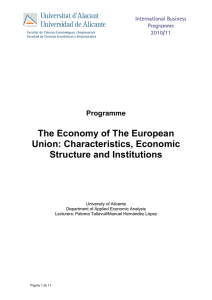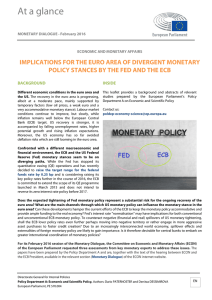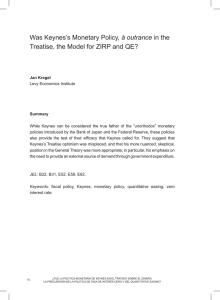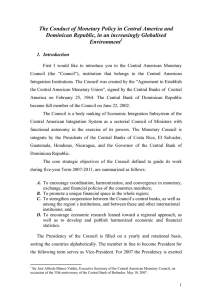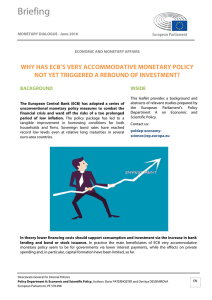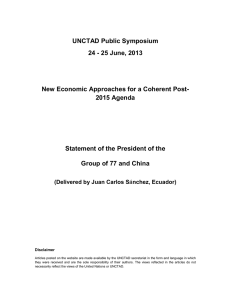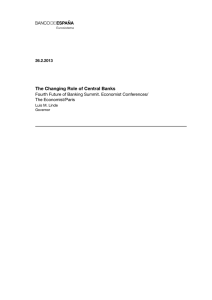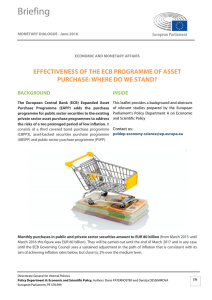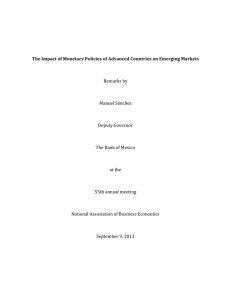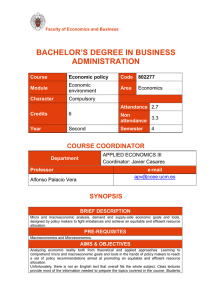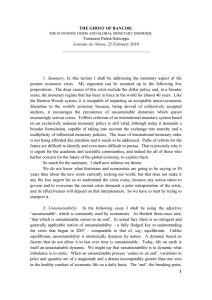The Economy of the European Union: Characteristics, Economic
Anuncio
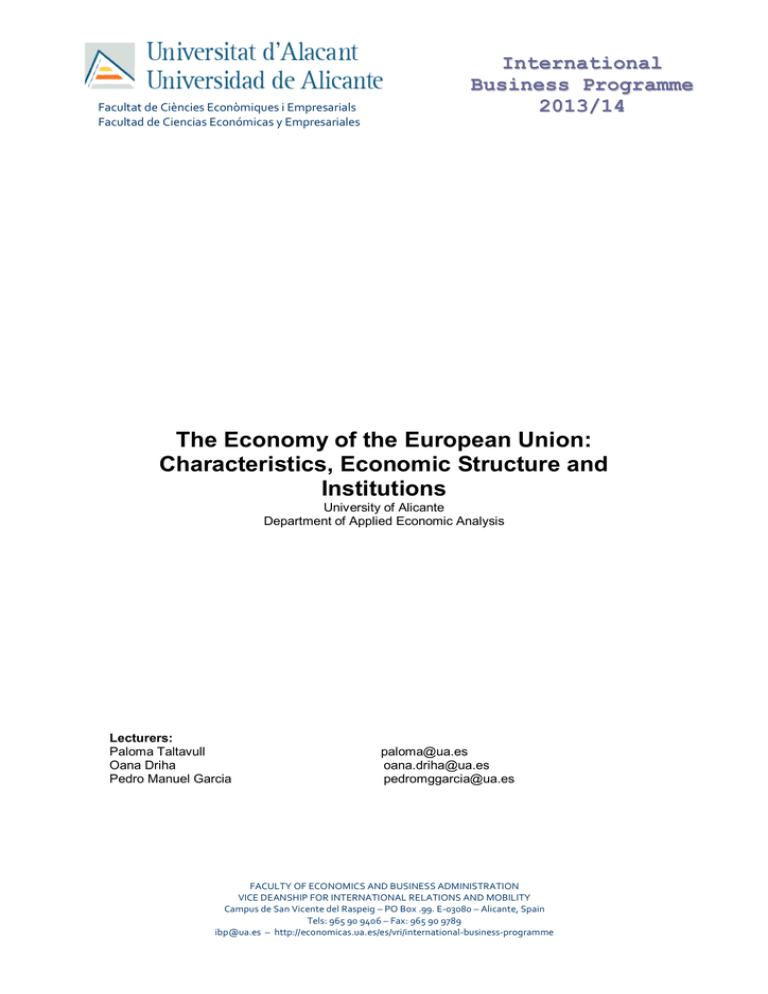
Facultat de Ciències Econòmiques i Empresarials Facultad de Ciencias Económicas y Empresariales International Business Programme 2013/14 The Economy of the European Union: Characteristics, Economic Structure and Institutions University of Alicante Department of Applied Economic Analysis Lecturers: Paloma Taltavull Oana Driha Pedro Manuel Garcia [email protected] [email protected] [email protected] FACULTY OF ECONOMICS AND BUSINESS ADMINISTRATION VICE DEANSHIP FOR INTERNATIONAL RELATIONS AND MOBILITY Campus de San Vicente del Raspeig – PO Box .99. E-03080 – Alicante, Spain Tels: 965 90 9406 – Fax: 965 90 9789 [email protected] – http://economicas.ua.es/es/vri/international-business-programme Facultat de Ciències Econòmiques i Empresarials Facultad de Ciencias Económicas y Empresariales International Business Programme 2013/14 OBJETIVES The subject aims to analyze the past, present and future of European integration, on the basis of historic and economic reasoning. The process of European integration and its effects will be assessed taking into account differences in European Member States economies as well as considering the EU as a whole at the international level. METHODOLOGY Learning will be based on both lectures and practical exercises: Lectures will provide for a broad overview of each topic and for the theoretical framework of the units. Practical exercises will consist both of pieces of coursework presented by students focusing on the analysis of a Lessonicular topic and conferences held by visiting EU officials. ASSESMENT 1.- A student discussion paper on a specific topic (30%) 2.- Practical exercises (30%) 3.- A written exam (40%) CONTENTS Content of the theoretical sessions 1. Introduction to the European integration process 1.1. Economic integration 1.2. The origin of the European integration process 1.3. From the European Union Treaty to present 2. European Union Institutions 2.1. Power and responsibility distribution between European Institutions 2.2. Las principales instituciones comunitarias: Consejo Europeo, Comisión, Consejo de Ministros y Parlamento Europeo. 3. The way to the Monetary Union 3.1. From Bretton Woods to the Monetary Union 3.2. Incomplete monetary unions: the 1992-1993 crisis of the European Monetary Union 4. The Economic and Monetary Union 4.1. Objectives of the EMU 4.2. Economic policy coordination 4.3. Multilateral supervision procedure 4.4. Fiscal policy and its obstacles 4.5. Growth and Stability Pact (GSP) 4.6. Euro crisis 4.7. Monetary and Exchange policy 4.8. European Central Bank (ECB) and the European System of Central Banks 4.9. ECB and the Federal Reserve y la FED 5. European Union, convergence conditions and Optimal Currency Areas 5.1. La Unión Monetaria evaluada a través del esquema coste-beneficio. 5.2. Las condiciones de convergencia para la UEM del TUE: una discusión. 5.3. Valoración de la UE como un área monetaria óptima (AMO) FACULTY OF ECONOMICS AND BUSINESS ADMINISTRATION VICE DEANSHIP FOR INTERNATIONAL RELATIONS AND MOBILITY Campus de San Vicente del Raspeig – PO Box .99. E-03080 – Alicante, Spain Tels: 965 90 9406 – Fax: 965 90 9789 [email protected] – http://economicas.ua.es/es/vri/international-business-programme Facultat de Ciències Econòmiques i Empresarials Facultad de Ciencias Económicas y Empresariales International Business Programme 2013/14 a. La teoría de las AMO. b. Los resultados de los trabajos empíricos c. El PGUE 6. Consequences of the European Integration 6.1. Convergence in the European Union 6.2. Unemployment in Europe 6.3. Rigidity of the European labor market 6.4. Macroeconomic shocks and unemployment in EU Contents of practical sessions Economic Integration: trade agreements and consequences European Union Institutions EU and USA: comparing the labor market EU and USA: economic growth SOME REFERENCES INCLUDING THE EU HISTORY Artis, M.J. and Lee, N.(1997), The Economics of the European Union, 2º ed., Oxford University Press Hitiris, T.(1998), European Union Economics, Prentice Hall Europe Myro, R.(2000), Economía Europea: Crecimiento, integración y transformaciones sectoriales, Civitas El-Aagra, A. (1998), The European Union, Prentice Hall, Europe. De Grauwe, P. (2007), Economic of monetary union, Oxford University Press De Grauwe, P. (2012), Economics of Monetary Union, Oxford University Press MAIN SOURCES Electronic references: Some electronic sources: Http://europa.eu.int http://europa.eu.int/publications Treaties http://www.europarl.eu.int/basicdoc EU Directives http://europa.eu.int/eur-lex Economic papers and Euro papers, http://www.europarl.eu.int/studies http://www.europarl.eu.int/comm/publications GUIDELINES TO WRITE THE FINAL REPORT: Students have to cover the following chapters in each issue: .1.1. Introduction to the subject: Description and problematic .1.2. Legal European Union basis: Directives related to the issue .1.3. How directives are implemented .1.4. Economic analysis of the issue (more than descriptive) .1.5. General assessment .1.6. Conclusions Each discussion paper has to be presented by students in the lectures time. During and after the presentation, discussion about the issue by students and teachers is recommended. FACULTY OF ECONOMICS AND BUSINESS ADMINISTRATION VICE DEANSHIP FOR INTERNATIONAL RELATIONS AND MOBILITY Campus de San Vicente del Raspeig – PO Box .99. E-03080 – Alicante, Spain Tels: 965 90 9406 – Fax: 965 90 9789 [email protected] – http://economicas.ua.es/es/vri/international-business-programme Facultat de Ciències Econòmiques i Empresarials Facultad de Ciencias Económicas y Empresariales International Business Programme 2013/14 Topics to work on will be agreed by lecturers and student. TOPICS COVERED DURING DIFFERENT COURSES 1. The EU trade Policy: internal (Single market economic philosophy, main compulsory rules, policies –public aids-and organizational framework, Freedom of investment, payments, and capital.) 2. Economic convergence prior to EMU: setting criteria and economic philosophy. The debate. The macro benefits of the convergence efforts. 3. The Economic Union : “Modus operandi” of Institutions: Commission and Parlament. Is there a need for an economic European “Government”?. 4. Sustainable growth through fiscal policy: description and reasons for Stability and Growth Pact. The debate nowadays. 5. The Monetary Union: Institutional issues: The European bank system and the channels of monetary stock control.. The role of ECB and autonomy,… Is there a lack of sovereignty? 6. The Monetary Union: “The” objective of Monetary Policy. The problem of asymmetric shocks. The i-rates setting. 7. The Monetary Union: Analysis of the introduction of the euro. Pros/cons of a single currency. Assessment. The euro evolution in the exchange markets after 2 years. 8. Economic convergence prior to EMU: setting criteria and economic philosophy. The debate. The macro benefits of the convergence efforts. 9. The Economic Union : “Modus operandi” of Institutions: Commission and Parlament. Is there a need for an economic European “Government”?. 10. Sustainable growth through fiscal policy: description and reasons for Stability and Growth Pact. The debate nowadays. 11. The Monetary Union: Institutional issues: The European bank system and the channels of monetary stock control.. The role of ECB and autonomy, Is there a lack of sovereignty? 12. The Monetary Union: The objective of Monetary Policy. The problem of asymmetric shocks. The i-rates setting. The Monetary Union: Analysis of the introduction of the euro. Pros/cons of a single currency. Assessment. The euro evolution in the exchange markets after 2 years. 14. Industrial Policies and the general issue of “public aids 15. Fiscal matters: ex, the with-holding tax issue 16. The EU Constitution 17. EU enlargement policy. Turkey, Croatia or other countries 18. EU Frontiers 19. Security and military issues in the EU 20. Stability and Growth Pact and the GIPSI problem 21. European Union Budget 22. “EU Employment and Social Situation Quarterly Review” 23. Eastern European Union Enlargement FACULTY OF ECONOMICS AND BUSINESS ADMINISTRATION VICE DEANSHIP FOR INTERNATIONAL RELATIONS AND MOBILITY Campus de San Vicente del Raspeig – PO Box .99. E-03080 – Alicante, Spain Tels: 965 90 9406 – Fax: 965 90 9789 [email protected] – http://economicas.ua.es/es/vri/international-business-programme
